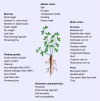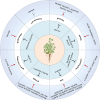Advances in basic biology of alfalfa (Medicago sativa L.): a comprehensive overview
- PMID: 40343348
- PMCID: PMC12058308
- DOI: 10.1093/hr/uhaf081
Advances in basic biology of alfalfa (Medicago sativa L.): a comprehensive overview
Abstract
Alfalfa (Medicago sativa L.), a perennial legume forage, has been broadly cultivated owing to a variety of favorable characteristics, including comprehensive ecological adaptability, superior nutritive value and palatability, and nitrogen fixation capacity. The productivity traits of alfalfa, specifically its biomass yield and forage quality, are significantly influenced by a series of determinants, including internal developmental factors and external environmental cues. However, the regulatory mechanisms underlying the fundamental biological problems of alfalfa remain elusive. Here, we conducted a comprehensive review focusing on the genomics of alfalfa, advancements in gene-editing technologies, and the identification of genes that control pivotal agronomic characteristics, including biomass formation, nutritional quality, flowering time, and resistance to various stresses. Moreover, a molecular design roadmap for the 'ideal alfalfa' has been proposed and the potential of pangenomes, self-incompatibility mechanisms, de novo domestication, and intelligent breeding strategies to enhance alfalfa's yield, quality, and resilience were further discussed. This review will provide comprehensive information on the basic biology of alfalfa and offer new insights for the cultivation of ideal alfalfa.
© The Author(s) 2025. Published by Oxford University Press on behalf of Nanjing Agricultural University.
Conflict of interest statement
All authors declare no conflict of interest.
Figures




Similar articles
-
Molecular Mechanisms of Alfalfa Response to Abiotic Stresses.Plants (Basel). 2025 Feb 6;14(3):487. doi: 10.3390/plants14030487. Plants (Basel). 2025. PMID: 39943049 Free PMC article. Review.
-
Integrated agronomic, physiological, microstructure, and whole-transcriptome analyses reveal the role of biomass accumulation and quality formation during Se biofortification in alfalfa.Front Plant Sci. 2023 Jul 20;14:1198847. doi: 10.3389/fpls.2023.1198847. eCollection 2023. Front Plant Sci. 2023. PMID: 37546260 Free PMC article.
-
Genetic Engineering of Alfalfa (Medicago sativa L.).Protein Pept Lett. 2016;23(5):495-502. doi: 10.2174/0929866523666160314152618. Protein Pept Lett. 2016. PMID: 26972972
-
Biotechnological Perspectives of Omics and Genetic Engineering Methods in Alfalfa.Front Plant Sci. 2020 May 21;11:592. doi: 10.3389/fpls.2020.00592. eCollection 2020. Front Plant Sci. 2020. PMID: 32508859 Free PMC article. Review.
-
Identification and characterization of regulatory pathways involved in early flowering in the new leaves of alfalfa (Medicago sativa L.) by transcriptome analysis.BMC Plant Biol. 2021 Jan 6;21(1):8. doi: 10.1186/s12870-020-02775-9. BMC Plant Biol. 2021. PMID: 33407121 Free PMC article.
Cited by
-
Natural Selection as the Primary Driver of Codon Usage Bias in the Mitochondrial Genomes of Three Medicago Species.Genes (Basel). 2025 May 30;16(6):673. doi: 10.3390/genes16060673. Genes (Basel). 2025. PMID: 40565565 Free PMC article.
-
Enhancing Alfalfa (Medicago sativa) Seed Yield: The Effect of Honey Bee (Apis mellifera) Supplementation and Efficiency of Other Pollinators.Biology (Basel). 2025 May 25;14(6):599. doi: 10.3390/biology14060599. Biology (Basel). 2025. PMID: 40563851 Free PMC article.
References
-
- Singer SD, Hannoufa A, Acharya S. Molecular improvement of alfalfa for enhanced productivity and adaptability in a changing environment. Plant Cell Environ. 2018;41:1955–71 - PubMed
-
- Latif A, Sun Y, Noman A. Herbaceous alfalfa plant as a multipurpose crop and predominant forage specie in Pakistan. Front Sustain Food Syst. 2023;7:1126151
LinkOut - more resources
Full Text Sources

